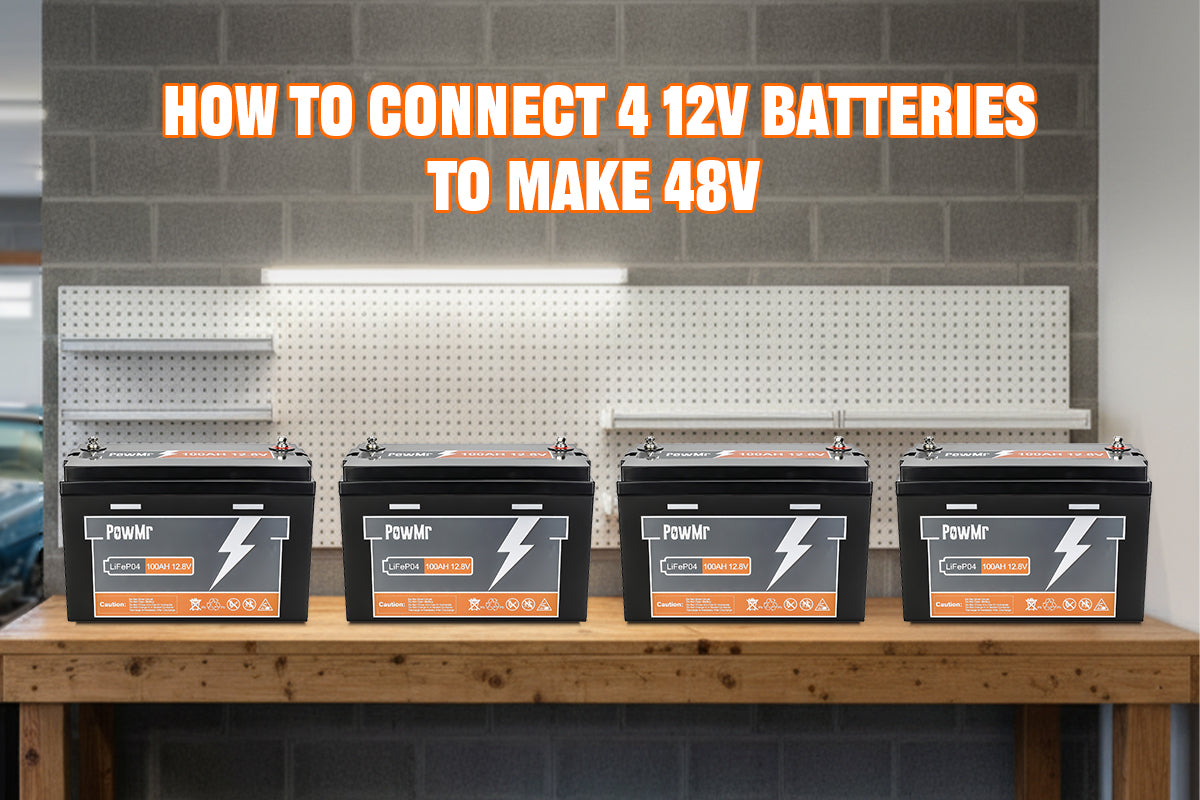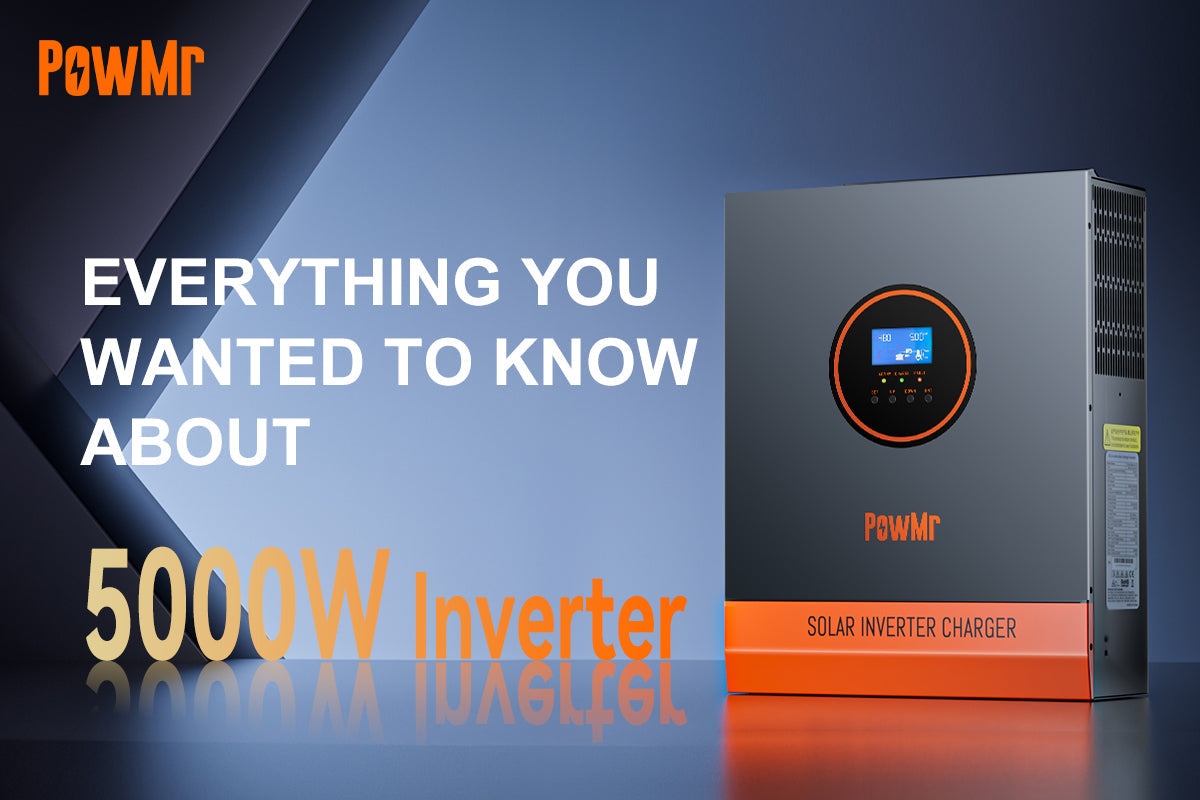Creating a 48V system from 12V batteries is essential for many applications, such as residential solar energy systems and electric vehicle, offering improved efficiency, reduced current loss, and greater compatibility.
If you're looking to build a 48V system using 12V batteries, understanding the wiring process is essential. Whether for solar systems, backup power, or other applications, this guide will walk you through the steps, recommend wire sizes, and explain the connections with easy-to-follow instructions and diagrams.
How to get 48v from 12v batteries
To get 48V from a 12V battery, you can use two primary methods: a series connection of batteries or a DC-DC converter.
A DC-DC converter electronically steps up the voltage from 12V to 48V. It’s compact and allows you to use a single 12V battery. This method is ideal for small to medium loads, it is limited by the converter's power capacity and may be less efficient for systems requiring high power.
However, if the goal of achieving 48V is to meet higher energy demands, it is more recommended to connect four 12V batteries in series. This method is more efficient and better suited for high-power applications.
What size wire for 48v battery bank connections
The size wire for connecting the battery mainly depends on the length of the cable you will run and how many current will the inverter draw.
So, before selecting wire for the batteries connection, arrange physically the batteries considering the distance between the batteries as short as possible to reduce voltage drop then measeure.
Assuming your inverter is rated at 3000W, the current for a 48V battery system is 3000W ÷ 48V = 62.5A. For a 5-meter cable length to connect the four 12V batteries in series to make 48V, 2 AWG wire is ideal, safely handling up to 85A with minimal voltage drop.
How to connect 4 12v batteries to make 48v
Besides selecting the proper wire size, ensure that all four lithium batteries share the same parameters, including a rated voltage of 12V, capacity, and age. If using a Battery Management System (BMS), confirm it supports parallel connections.
Step1. Position the batteries
Start by placing the batteries in a secure, well-ventilated area, ensuring they are properly aligned to simplify cable connections. Once positioned, identify each battery's terminals: the positive (+) and negative (-). If needed, label the terminals to avoid confusion during the setup.
Step2. Connect the batteries in series
To connect the batteries, link the negative terminal (-) of the first battery to the positive terminal (+) of the second battery. Continue this sequence—positive to negative—creating a chain that leaves two terminals unconnected:
The positive terminal (+) of the first battery and the negative terminal (-) of the fourth battery. These will serve as connection points for the inverter.

Step 3. Verify the connection
Use a multimeter to verify the total voltage between these two unconnected terminals. It should read approximately 48V.
Step4. Connect the battery chain to the inverter
With the DC breaker in the "OFF" position, connect the battery chain's positive (+) and negative (-) terminals to the inverter's DC inputs through the breaker.
How to connect 8 12v batteries to make 48v
However, let’s expand on this concept. If you create a 48V system by connecting four 12V batteries in series to make 48v and then duplicate or multiply this setup for any purpose, an additional limitation arises that may affect the wire size.
Related Article:
How to Wire Batteries in Series and Parallel at the Same Time
Critical considerations for paralleling 48v strings of 4x 12v batteries
In a parallel circuit, the current is evenly drawn from each battery string. However, if a single battery in one string fails (e.g., due to an open or short circuit), the entire string will typically stop functioning. Meanwhile, the remaining functional string(s) will continue to supply power to the inverter but will bear the full load current. This may exceed the string’s maximum rated current, leading to overheating or other issues, potentially shortening the battery's lifespan or causing damage.
Imagine a setup with a 5000W inverter connected to eight 12V batteries, each capable of discharging up to 100A. So, in a single string, the discharge current is also capped at 100A. When you connect two identical systems in parallel, the total maximum discharge current doubles to 200A. Since the inverter draws approximately 105A at full load (5000W ÷ 48V), the current demand is shared between the two battery strings. In ideal situation, each string supplies 52.5A, ensuring smooth operation without any issues.
However, if one battery string fails, the remaining string would suddenly need to handle the entire 105A load. At this point, the Battery Management System (BMS) may disconnect the battery due to excessive current draw. If no BMS is present, the battery could overheat or become damaged.
Since no single string can independently handle the full current, we recommend the following solutions:
- Using a Battery Management System (BMS) is strongly recommended in this scenario. The BMS will automatically disconnect the battery connection when necessary, ensuring protection from excessive current draw. In this case, cables with an ampacity matching the inverter’s maximum current draw should be chosen. In the example above, for a 5-meter length, 1/0 AWG cable is appropriate to connect the eight 12V batteries and safely handle 105A.
- If there is no BMS, install a dedicated fuse for each battery pack, rated for its maximum continuous discharge current. Select cables based on each pack's individual maximum discharge current (e.g., for a 100A battery, use 2 AWG cables rated for 100A over a 5-meter distance). This ensures that if a battery fails, the fuse will blow, protecting the remaining packs from overcurrent damage and isolating the faulty pack.
Step1. Ensure proper cable preparation
After selecting the proper wire size, cut cables to equal lengths and use uniform lug sizes to maintain consistent resistance and current flow across the connections. Uneven cable lengths can lead to inefficiencies, overheating, or damage to your batteries. Use a cable cutter and crimping tool to make clean cuts and secure connections. Insulate exposed sections with heat shrink tubing or electrical tape for safety.
Step2. Wire 4x 12v batteries in series for 48v string
Divide the 8 batteries into two sets of four. Arrange them to allow easy access to their terminals and keep the distance between batteries as short as possible.
For each string, connect four 12V batteries in series using the method described earlier in the article. Once completed, you’ll have two separate 48V strings, each with one positive and one negative terminal unconnected, totaling four open terminals.
If you’re working with more batteries—12, 16, or 20—simply repeat the same series connection principle to create additional 48V strings. The process remains consistent regardless of the total number of batteries.

Step3. Install protection devices
If you encounter the issue we discussed above, where the maximum discharge current of a single string is less than the maximum current consumed by the loads, install protective devices to safeguard the system.
If available, integrate a Battery Management System (BMS) to monitor the batteries and provide advanced protection against overcurrent, overvoltage, and undervoltage, ensuring system reliability and safety. Please refer to the manual for installation instructions.
When a BMS is not available, place a fuse on the positive terminal of each battery string, appropriately rated for its maximum continuous discharge current. This measure isolates any faulty strings during a malfunction, protecting the entire system.
Step4. Connect the 48v battery system in parallel
For easier and safer parallel connections, consider using battery busbars or terminal blocks. This ensures a solid and uniform connection while reducing the risk of loose or uneven wiring.
Ensure it is rated to handle the combined current from all the strings. For example, if each string can deliver 100A, and you have two strings, the bus bar should support at least 200A.
Connect the strings by linking terminals of the same type (positives to positives and negatives to negatives) to the corresponding busbar. This setup evenly distributes current between the strings and simplifies integration into the system.
Step5. Connect the battery bank to the inverter
Use a multimeter to confirm the total voltage at the output terminals of the parallel-connected battery bank. It should read approximately 48V.
With the inverter’s DC breaker in the "OFF" position, connect the battery bank's positive terminal (+) to the inverter's positive DC input and the negative terminal (-) to the inverter's negative DC input.
Conclusion
Building a 48V system from 12V batteries is an efficient and practical solution for high-power applications such as solar energy systems and electric vehicles. Key considerations include the system's current demand and the cable length, as these directly impact voltage drop and wire size selection, ensuring optimal performance.
Equally important are the inverter's efficiency and maintaining a voltage drop below 3%. Choosing the right wire size and battery fuse is crucial to ensure safety and maximize system efficiency.


